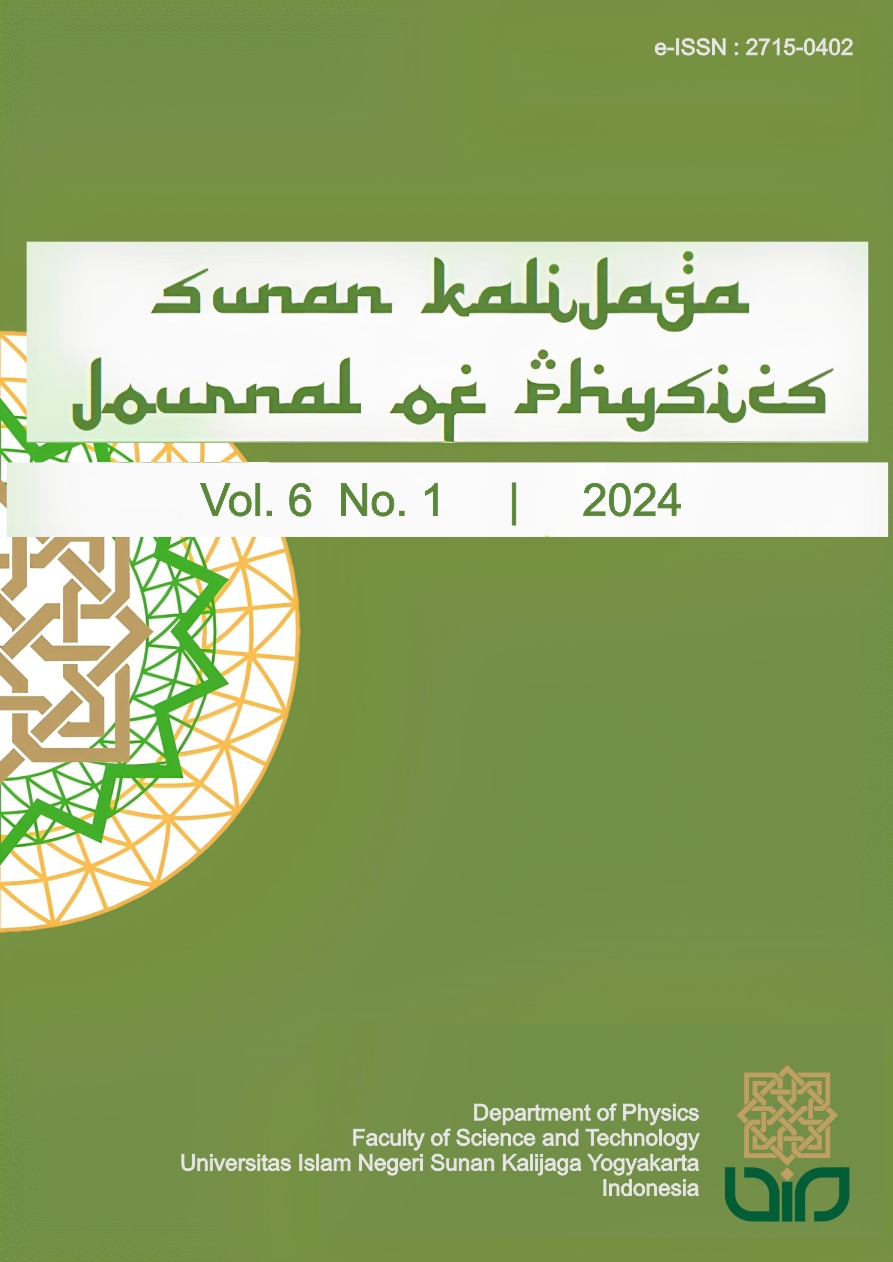Seismic Disaster Study Based on Soil Vulnerability Index (Kg) and Peak Ground Acceleration (PGA) Values in Kokap and Surrounding Areas
Studi Kebencanaan Seismik Berdasarkan Nilai Indeks Kerentanan Tanah (Kg) dan Perecepatan Tanah Maksimum (PGA) di Daerah Kokap dan Sekitarnya
DOI:
https://doi.org/10.14421/physics.v6i1.5154Keywords:
Earthquake, Hargorejo, HVSR, Kokap, PGA, SeismicAbstract
Kulon Progo region is one of the areas in Yogyakarta that often experiences natural disasters, especially landslides. With the morphology of mountains that are described as large domes with flat tops and steep wings (Van Bamelen, 1949), making the Kulon Progo area more prone to landslides. Earthquakes with great force can cause landslides in this area. To map areas that are prone to earthquakes and landslides, research using the microseismic method was used. The research is located in Hargorejo Village and Hargowilis Village, Kokap District and Karangsari Village, Pengasih District, DI. Yogyakarta consists of 9 measurement points. Data processing was performed using Geopsy software using the HVSR method. The results showed that the Kokap area and its surroundings had an amplification factor value range of 1-5 times, the natural frequency value was 1.2 Hz to 12.2 Hz, the dominant period value was 0.5-0.8 s, the soil vulnerability index value was , 1 /cm to 2.7 /cm and a PGA value of 64 cm/ to 206.2 cm/ . Based on the research results, the area most vulnerable to the consequences of the earthquake is the village of Hargorejo. The village of Hargorejo which is composed of andesite intrusion has resulted in mineral alteration which produces clay minerals where clay minerals are impermeable so that they easily become sliding fields. When an earthquake occurs, this area will suffer significant damage.
References
BMKG, Buletin Meteorologi dan Geofisika No. 4, Jakarta, 1998.
BMKG, Katalog Gempabumi Signifikan dan Merusak 1821–2018, Earthquake and Tsunami Center, Jakarta, 2019.
D. Edwina and S. Novita, “Pemetaan Percepatan Tanah Maksimum dan Intensitas Seismik Kota Padang Panjang menggunakan Metode Kanai,” Jurnal Teknik Sipil Universitas Andalas, vol. 2, no. 2, p. 9, 2008.
I. Gurler et al., “Local Site Effect of Mexico City Based on Microtremor,” in Proc. 6th Int. Conf. on Seismic Zonation, Palm Spring Riviera Resort, California, USA, 2000, pp. 65.
N. Haerudin, F. Alami, and Rustadi, Mikroseismik, Mikrotremor dan Microearthquake dalam Ilmu Kebumian, Bandar Lampung: Pustaka Media, 2019.
S. Hidayat, “Aplikasi Metode Horizontal to Vertical Spectral Ratio Pada Perhitungan Frekuensi Natural dan Amplitudo HVSR,” in Pros. Pertemuan XXXI IIFI Jateng & DIY, Yogyakarta, 2017.
K. Kanai and T. Tanaka, “On Microtremors VIII,” Bull. Earthquake Res. Inst. Univ. Tokyo, 1961.
K. Kanai, “Improved Empirical Formula For Characteristics of Stray [Sic] Earthquake Motions,” 1966, pp. 1–4.
Y. Nakamura, “A Method For Dynamic Characteristics Estimation of Subsurface Using Microtremor on the Ground Surface,” Railway Technical Research Institute, Quarterly Reports, 1989.
Y. Nakamura, “Clear Identification of Fundamental Idea of Nakamura’s Technique and its Application,” in Proc. 12th World Conf. on Earthquake Engineering, Beijing, China, 2000.
Y. Nakamura, “Inventory Development for Natural and Built Environments: Use of Seismic Motion and Microtremor for Vulnerability Assessment,” in Proc. 4th EQTAP Workshop, Kamakura, 2001.
Y. Nakamura, “Clear On The H/V Spectrum,” in Proc. 14th World Conf. on Earthquake Engineering, Beijing, China, 2008.
M. Ozaki, Y. Kitagawa, and S. Hattori, “Study on Regional Distribution of Peak Earthquake Motions in Japan,” in Proc. Ninth Joint UJNR Panel Conf. on Wind and Seismic Effects, 1977, pp. 14–44.
W. Rahardjo, H. Sukandarrumidi, and H. M. D. Rosidi, Peta Geologi Lembar Yogyakarta, Jawa Skala 1:100.000, Bandung: Geology Research and Development Center, 1977.
Trifatama Rahmalia and Fadlin, “Studi Hubungan Tingkat Alterasi Terhadap Potensi Longsoran Berdasarkan Analisis Petrografi dan X-ray Difraction Sepanjang Jalan Arjosari–Tegalombo, Kabupaten Pacitan, Provinsi Jawa Timur,” Purwokerto: UNSOED, 2014.
J. Saita et al., “On Relationship Between The Estimated Strong Motion Characteristic of Surface Layer and The Earthquake Damage,” in Proc. 13th World Conf. on Earthquake Engineering, Vancouver, B.C., Canada, 2004.
SESAME, Guidelines for The Implementation of H/V Spectral Ratio Technique on Ambient Vibrations Measurements, Processing and Interpretation, SESAME European Research Project, Project No. EVG1-CT-2000-00026, 2004.
J. R. Setiawan, Mikrozonasi Seismisitas Daerah Yogyakarta dan Sekitarnya, Thesis, Bandung: ITB, 2009.
A. Susilo and S. A. Wiyono, “Frequency Analysis and Seismic Vulnerability Index by Using Nakamura Methods at a New Artery Way in Porong, Sidoarjo, Indonesia,” Int. J. of Applied Physics and Mathematics, vol. 2, no. 4, pp. 227–230, 2012.
USGS, “The Modified Mercalli Intensity Scale.” [Online]. Available: http://earthquake.usgs.gov/learn/topics/mercalli.php
R. W. Van Bemmelen, The Geology of Indonesia, Amsterdam: The Hague, Government Printing Office, 1949.
Downloads
Published
How to Cite
Issue
Section
License
Copyright (c) 2025 Dita Andini

This work is licensed under a Creative Commons Attribution-ShareAlike 4.0 International License.




